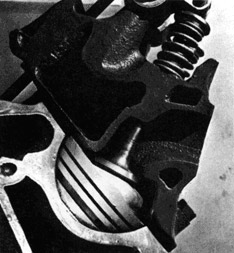Do you know your VOTC?

WHAT IS VOTC?
VOTC is ISKY'S revolutionary new concept in aiding in the selection and installation of a racing camshaft. VOTC (Short for VALVE OPENING AT TOP DEAD CENTER) is "the amount the valves are actually off their seats at TDC" during overlap. How does this help you? Well very simply it will tell you whether or not the racing camshaft you're thinking of installing in your engine will be tolerated. In other words will it install with sufficient V/P(Valve to Piston) clearance?
WHY WORRY ABOUT VOTC?
Very simply VOTC has a direct bearing on your V/P clearance because as VOTC increases V/P clearance decreases. Unfortunately the most unasked question by racers installing a particular racing camshaft is "Will my valves clear my pistons?" This most important aspect is very often overlooked and many engines are damaged by insufficient V/P (Valve to Piston) clearance. If the camshaft is a mild hydraulic grind to be installed in a low compression stock engine, there is usually NO PROBLEM. However with the multitude of engine models, from year to year, having variables such as cylinder head combustion chamber volume, compression ratio, stock camshaft, etc., it is becoming impossible to give a definite yes or no answer as to V.P.C. (Valve/Piston Clearance). Even when using special racing pistons, insufficient V.P.C. can result when long overlap cams are employed. Racers are very often disheartened when finally assembling a short block to discover the engine is suffering from inadequate V.P.C. and must now be disassembled in order to fly cut the pistons for additional relief. But there's even a more painful feeling; that's when 'the mechanic fails to even bother to check V.P.C. and on the first fire up a $1000 engine goes up in smoke, (Bent Valves, Broken Piston and maybe even the block itself destroyed). ISKY TO THE RESCUE! Simply read the catalog and note the VOTC.
EXAMPLE: FOR ENGINES IN THE CAR
The simple removal of one intake and one exhaust valve spring on your engine will enable you to determine your V/P clearance with a modified camshaft. Begin by cranking the engine over to T.D.C. compression on #1 cyl. With ball-stud rocker arm engines remove the intake and exhaust rocker arms from #1 cyl. With shaft mounted rocker engines, it is necessary to remove the entire rocker shaft from the #1 cylinder side. ISKY'S Valve Spring Removal Kit is next used to remove the intake and exhaust valve springs. The kit includes an air fitting which threads into the spark plug hole and accepts shop air pressure to hold the valves up on their seats, and two "Light Tension Springs" that simulate the original springs and facilitate checking. (See page 16& 112 for photos and description.) Remove the #1 cyl. spark plug and replace it with the appropriate air fitting. Connect shop air pressure to the fitting and using the ISKY Valve Spring Removal Tool, remove the #1 cyl. intake and exhaust valve springs. Install ISKY'S "Light Tension" checking springs and replace the keepers and retainers. Release the air pressure and employ a dial indicator on the retainer or a graduate scale alongside, and now measure and record the distance of free valve travel from the seated position to the piston crown. You may then subtract the [SKY VOTC Value from this figure and determine what your actual V/P clearance will be when the Isky cam is installed. Follow the same procedure to determine your exhaust V/P clearance. Having accomplished this reconnect the shop air pressure to the cylinder replace the regular intake and exhaust valve springs, and the rocker arms to their original position.
EXAMPLE OF SUFFICIENT V/P CLEARANCE
The valve traveled distance from seated position to open, on a certain Chevy small block V-8 engine is .250" Int. and .270" Ex. The VOTC for the desired ISKY 310 Hyd. cam is.132", hence 250" travel minus .132" VOTC = .118" Int. V/P clearance and.270" Travel minus .132" VOTC = .138" Ex. V/P clearance. This is greater than the tolerable minimum clearance of .100", so the 310° HYD. camshaft will install in this engine nicely.
EXAMPLE OF INSUFFICIENT CLEARANCE
Valve traveled distance seat to piston is .200" Int. and .210" Ex. Intake valve travel .200" minus .132" VOTC = .068" V/P clearance. Ex. Valve Travel .210" minus .132" VOTC = .078" V/P clearance. Since .068" and .078" are both under the tolerance .100"V/P minimum clearance, this cam will not install safely!
EXAMPLE: ENGINE ON ENGINE STAND
When building up an engine on the bench from scratch, you'll be ordering special racing piston no doubt. By all means do furnish the Piston Co. with the VOTC values pertinent to your cam-shaft plus your valve diameters. This way your piston reliefs (eye-brows) should be correct. But you can't be too careful! So let's install #1 piston (without rings) in the bore for the actual check of V/P clearance. (See page 112 "How to check for V/P clearance"). The table on the following page contains the pertinent V.0.T. C. values for all popular V.8 engines in use today. Space prohibits listing less popular V-8 and 6 cyl engines. However, should you desire VOTC information for any engine not listed, feel free to write the ISKY factory for this information. We know the Racer and Top Tuners will accept ISKY'S new term VOTC because it's needed and long over due. We suspect our-contemporaries will fight the term and attempt to conjure up a new term to seal the credit for themselves. We at ISKENDERIAN refer to that as the "Penalty of Leadership."
